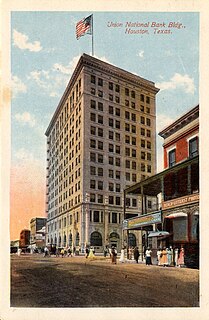 W
WThe Algonquin Hotel is an American historic hotel located at 59 West 44th Street in Midtown Manhattan, New York City. The hotel is a New York City designated landmark.
 W
WThe Algonquin Resort is a Canadian coastal resort hotel in the Tudor Revival style, located in St. Andrews, New Brunswick. An architectural icon of New Brunswick, the hotel is the most famous symbol of St. Andrews and one of the most photographed buildings in the province.
 W
WGeneral Patrick Hurley opened the Ambassador Hotel in 1929, intending it to be a luxury "extended stay" residence for Tulsa businessmen, who were building mansions that were not yet ready for occupancy. Hurley never stayed in the hotel he founded. He moved to Washington, D. C. in March 1929, after President Herbert Hoover chose him to be Secretary of War, after the death of the previous Secretary, who died in December 1929. Hurley never returned to Tulsa.
 W
WArrowhead Springs is a highly mountainous neighborhood in the 81-square-mile (210 km2) municipality of San Bernardino, California, officially annexed to the city on November 19, 2009. The neighborhood lies below the Arrowhead geological monument, which is California Historical Landmark #977.
 W
WAtlantis Paradise Island is an ocean-themed resort on Paradise Island in the Bahamas. It features a variety of accommodations built around Aquaventure, a 62-hectare (154-acre) waterscape, which includes fresh and saltwater lagoons, pools, marine habitats, water slides, and river rides.
 W
WThe Hotel Blackhawk is an eleven-story brick and terra cotta building located in Downtown Davenport, Iowa, United States. It is a Marriott Autograph Collection property.
 W
WThe Casa Monica Hotel is a historic hotel located in St. Augustine, Florida, in the United States. The Casa Monica Hotel is one of the oldest hotels in the United States and is a member of the Historic Hotels of America in the National Trust for Historic Preservation.
 W
WThe Cosmopolitan of Las Vegas is a luxury resort casino and hotel on the Las Vegas Strip in Paradise, Nevada. The resort opened on December 15, 2010, and is located just south of the Bellagio on the west side of Las Vegas Boulevard.
 W
WThe Davenport Hotel Collection is a brand collection of four upscale hotels in Spokane, Washington. All four hotels are located within several blocks of one another in Downtown Spokane.
 W
WThe Davenport Hotel is a hotel located in Spokane, Washington. Commissioned by a group of Spokane businessmen, the hotel is named after Louis Davenport, its first proprietor and overseer of the project. Architect Kirtland Cutter designed the building in 1914. The Davenport Hotel was the first hotel in the United States with air conditioning, a central vacuum system, pipe organ, and dividing doors in the ballrooms. It is also the place at which the first Crab Louis was created and served. The hotel is listed on the National Register of Historic Places.
 W
WFenway Hotel is a historic Jazz Age hotel building in Dunedin, Florida.
 W
WHotel ICON is a boutique hotel located in downtown Houston, Texas, USA. The hotel is part of Marriott International's Autograph Collection Hotels. Located in the former Union National Bank building that was constructed in 1911, the hotel was designed by San Francisco design firm Candra Scott & Anderson at the cost of $35 million. The 12-story hotel features 135 guest rooms and nine individually designed signature suites that include custom-designed period furnishings and décor with original artwork.
 W
WThe Lexington Hotel, Autograph Collection is a hotel in Midtown Manhattan, New York City.
 W
WParq Vancouver is a mixed-use development located adjacent to BC Place in Vancouver, British Columbia. The three towers house four-star hotels JW Marriott, The Douglas, a two-floor casino, eight restaurants and lounges which seat 846, a 2,800-square-metre (30,000 sq ft) open space on level 6 and 5,800 square metres (62,000 sq ft) of event space.
 W
WPowerscourt Estate, located in Enniskerry, County Wicklow, Ireland, is a large country estate which is noted for its house and landscaped gardens, today occupying 19 hectares. The house, originally a 13th-century castle, was extensively altered during the 18th century by German architect Richard Cassels, starting in 1731 and finishing in 1741. A fire in 1974 left the house lying as a shell until it was renovated in 1996.
 W
WThe Putnam-Parker Block, also known as City Square, are historic structures located in downtown Davenport, Iowa, United States. The property is three buildings that take up the south half of block 43 in what is known as LeClaire's First Addition. The main façade of the structures face south along West Second Street. They were listed on the National Register of Historic Places in 2011. In 2020 it was included as a contributing property in the Davenport Downtown Commercial Historic District. The former Putnam Building now houses a Marriott Autograph Collection hotel named The Current Iowa.
 W
WScrub Island of the British Virgin Islands in the Caribbean is a part of the Lesser Antilles, a group of islands that are young volcanic or coral islands. It is home to the Scrub Island Resort Marina and Spa.
 W
WThe Brown Palace Hotel, now The Brown Palace Hotel and Spa, Autograph Collection, is a historic hotel in Denver, Colorado, United States. It is listed on the National Register of Historic Places and is the second-longest operating hotel in Denver. It is one of the first atrium-style hotels ever built. It is now operated by HEI Hotels and Resorts, and joined Marriott's Autograph Collection Hotels in 2012. The hotel is located at 321 17th Street between 17th Street, Broadway and Tremont Place in downtown Denver behind the Republic Plaza. The main entrance door is on Tremont Place.
 W
WThreadneedles Hotel, formerly the head offices of the London, City and Midland Bank, is a 5-star London hotel with 74 rooms and suites. The hotel is located opposite the Bank of England on Threadneedle Street. It is a Grade II listed building.
 W
WNashville's Union Station is a former railroad terminal designed by Richard Montfort, chief engineer of the Louisville and Nashville Railroad, and built in 1900 to serve the passengers of the eight railroads that provided passenger service to Nashville, Tennessee, at the time. Built just west of the downtown area, it was spanned by a viaduct adjacent to the station and positioned to the east and above a natural railroad cut, through which most of the tracks in the area were routed. The station was also used by streetcars prior to their discontinuance in Nashville in 1941.